The 15 Best Climbing Shoes of 2024 (Expert Buying Guide)
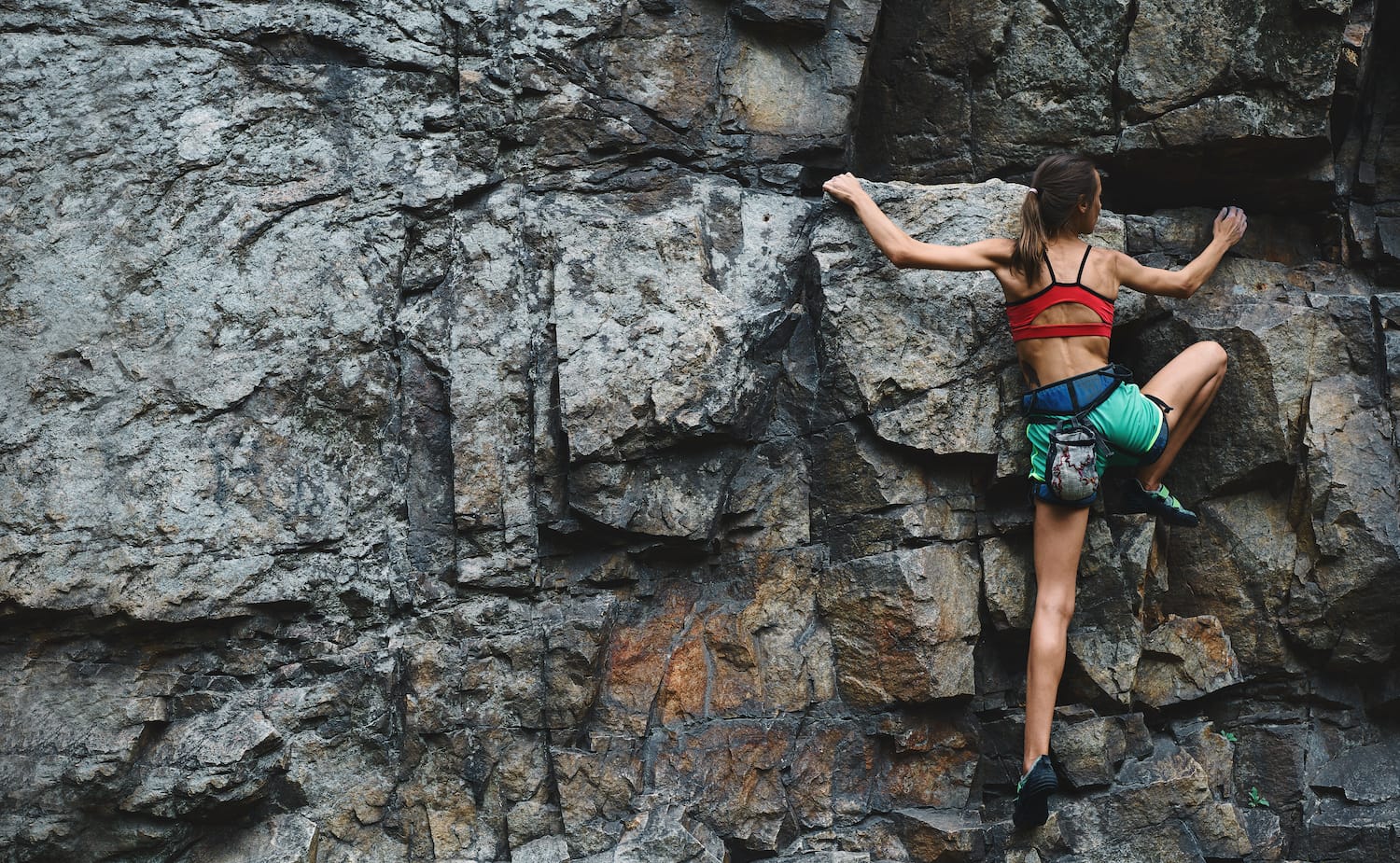
At any level, a great pair of climbing shoes is one of the most important pieces of climbing gear. While it will never replace training, picking the right model can go a long way to making your practice more enjoyable. At the very least, climbing shoes must support your progress and not hinder it.
Fortunately, these days climbers can choose from more brands and models of shoes than ever before. That also presents a dilemma: what to buy when there’s such a broad array of seemingly diverse and specialized climbing shoes on the market?
In this review, we’ve narrowed down the 15 best models of climbing shoes for a number of different uses and users. And because everyone likes options, we’re also offering an alternative pick in each category.
Whether you’re a beginner or an expert, you’ll find the right pair to take you further on your climbing journey!
Our Method
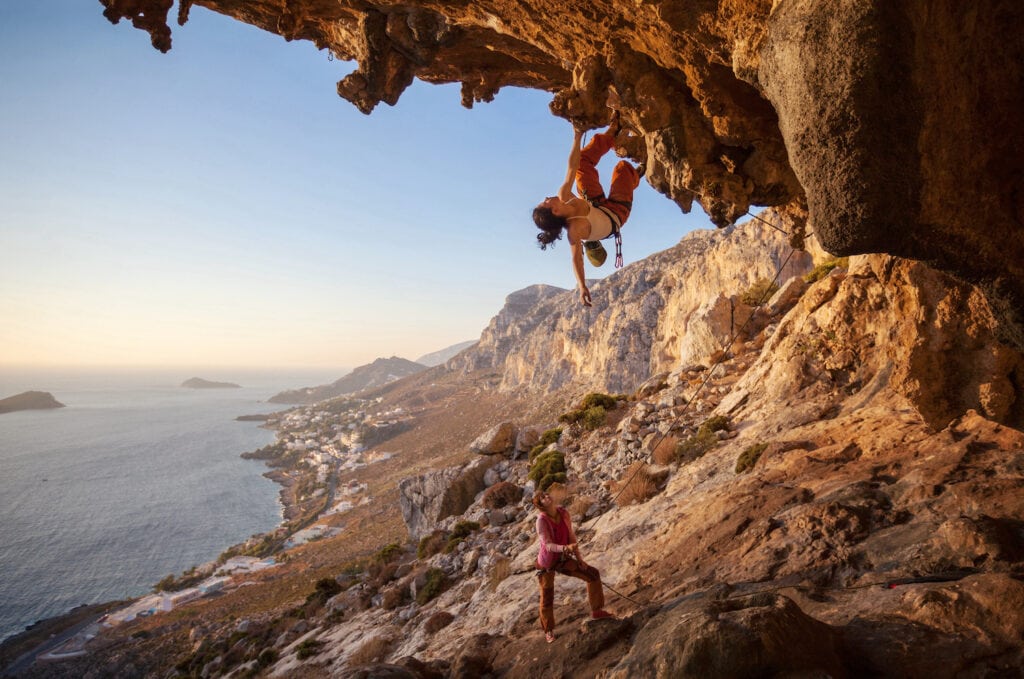
We based this roundup review on an analysis of our key factors to evaluate climbing shoes:
- Comfort
- Performance (edging, smearing, hooking, and jamming)
- Value
- Durability (quality and sustainability)
The main component of our ranking is our personal experience. However, individual reviews are subjective and must be verified by a thorough meta-analysis to distinguish the anecdotal from the significant. For this, we used dozen independent review sources, including:
- Climbing publications (magazines and blogs)
- Manufacturer and retailer e-commerce websites’ specs & reviews
- Reddit & other climbing forum testimonials
Using this qualitative and quantitative data, we selected 47 models. From there, we evaluated each model and picked the best for each of our categories defined to cover the largest audience of climbers possible.
Last but not least, we gathered an informal panel of climbing acquaintances to discuss their experience with the shoes we selected and confirm we didn’t miss anything.
Shoe Versions Tested
This review uses primarily data from men’s climbing shoe reviews. Many of the shoes have a corresponding women’s version, which shares the basic characteristics of the men’s model while using a narrower, lower-volume last.
Some shoe manufacturers, like Evolv, produce unisex models. Others make “low volume” models for women or people with narrower feet. Butora, a Korean company that is relatively new in the North American market, offers men’s and women’s shoes in narrow and wide variations.
And some women (and men) wear the opposite sex’s version of a particular shoe because it fits their foot shape better.
Remember, sometimes the best shoe for you is simply the one that best fits your foot rather than one supposedly designed for a particular climber or style of climbing. Don’t be afraid to experiment with different types.
Our Selection of the Best Climbing Shoes for 2024
Comparison Table
| Shoe Model | Type | Downturn | Best for | Vegan | Best Offer |
|---|---|---|---|---|---|
La Sportiva Miura VS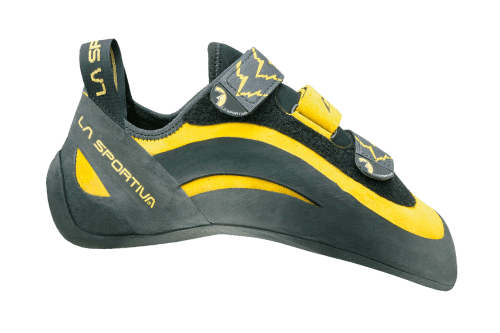 | Performance | Aggressive | Overall | ❌ | Check prices |
Butora Endeavor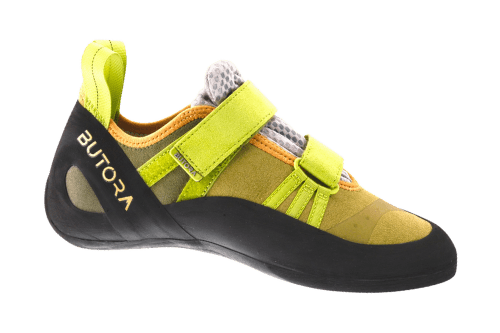 | Comfort | Neutral | Beginners | ❌ | Check prices |
La Sportiva Katana Lace | Performance | Moderate | Versatile Performance | ❌ | Check prices |
La Sportiva TC Pro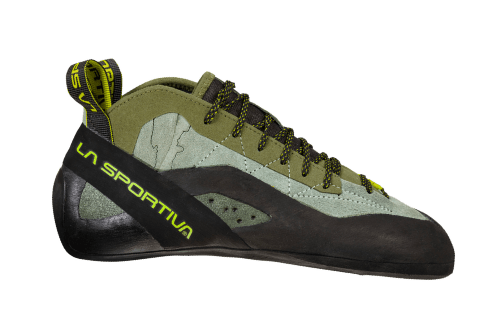 | Performance | Moderate | Crack/Trad | ❌ | Check prices |
Scarpa Instinct VS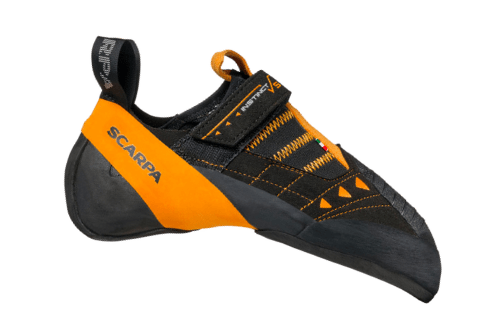 | Performance | Moderate | Bouldering | ❌ | Check prices |
La Sportiva Solution Comp | Performance | Aggressive | Sport/Steep | ❌ | Check prices |
Black Diamond Aspect | Comfort | Neutral | Low-Angle | ❌ | Check prices |
Five Ten NIAD VCS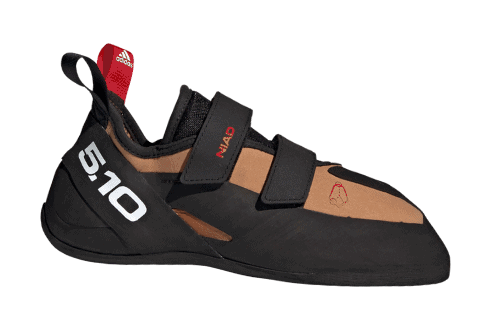 | Comfort | Neutral | All-Day | ❌ | Check prices |
La Sportiva Tarantulace | Comfort | Neutral | Budget | ❌ | Check prices |
Tenaya Oasi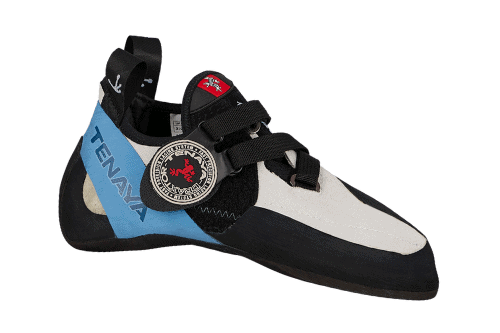 | Performance | Aggressive | Vegan | ✔ | Check prices |
La Sportiva Otaki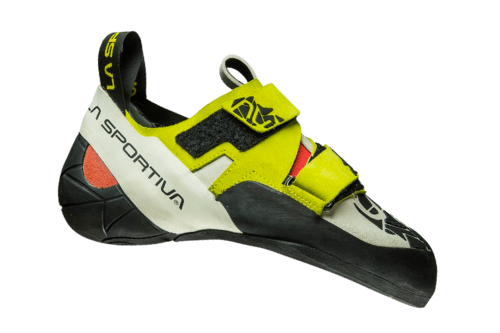 | Performance | Aggressive | Women | ❌ | Check prices |
Butora Acro Comp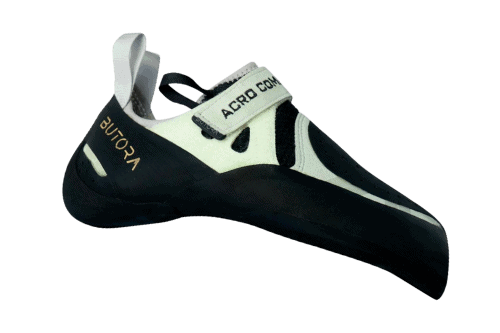 | Performance | Aggressive | Gym Climbing | ❌ | Check prices |
Black Diamond Momentum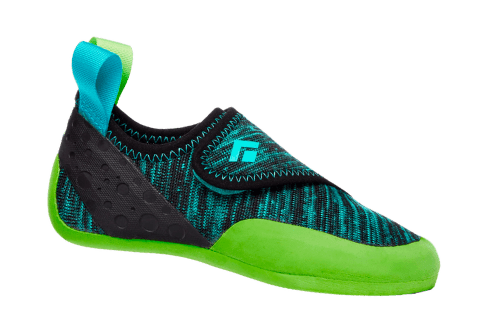 | Comfort | Neutral | Kids | ✔ | Check prices |
La Sportiva Skwama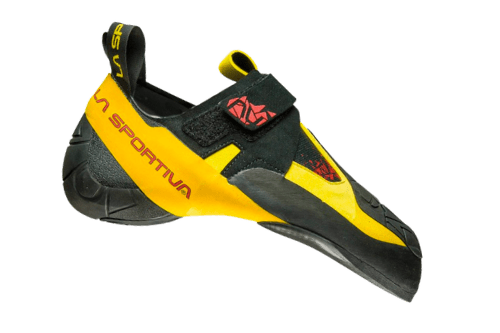 | Performance | Aggressive | High-Volume Feet | ❌ | Check prices |
Tenaya Iati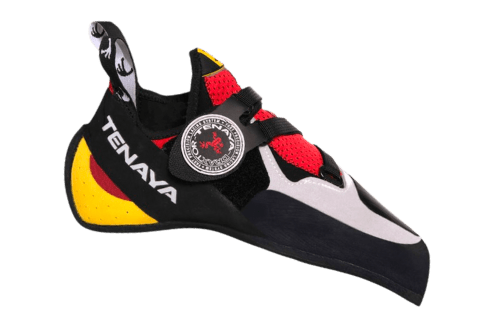 | Performance | Aggressive | Low-Volume Feet | ❌ | Check prices |
1. La Sportiva Miura VS: Best Overall Climbing Shoes
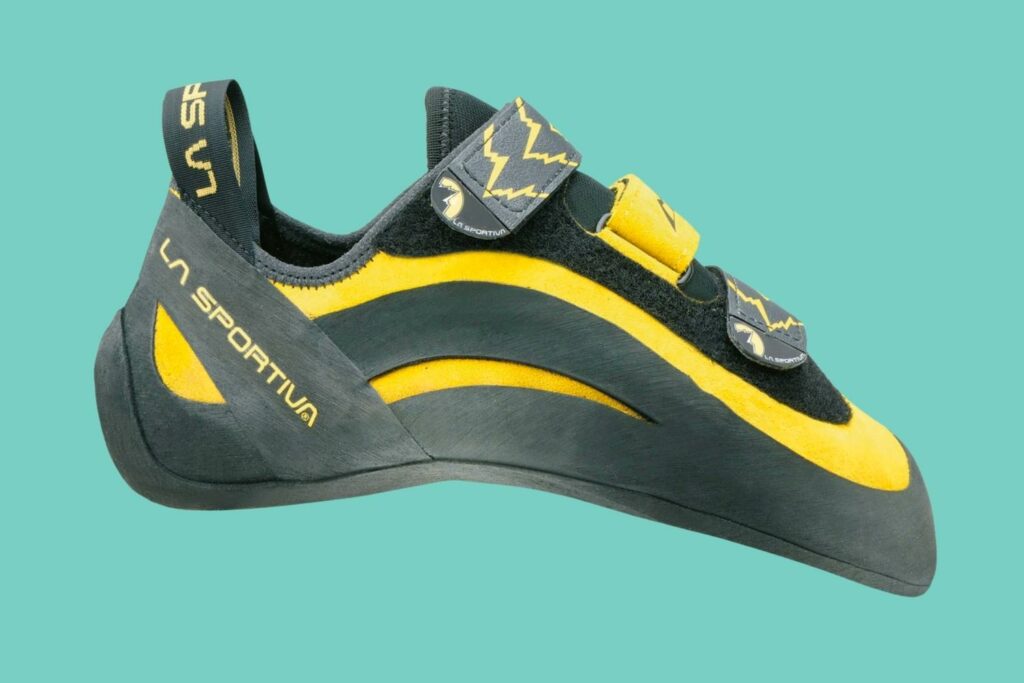
Facts
Outsole Rubber: Vibram XS Edge 4mm
Upper Material: Leather
Lining Material: Textile
Vegan: No
Resoleable: Yes
Do you want a versatile shoe that excels in various scenarios and rock types, from the hardest gym routes to technical multi-pitch? From overhung boulders to your latest sport project? La Sportiva’s Miura VS might be worth a look.
The Miura VS is a tried and true model that’s been around for years and updated several times. Go to any gym or popular sport crag, and you’re likely to see many well-used and resoled Miuras.
The Miura isn’t the most well-rounded shoe. It won’t suit most for hardcore trad climbing due to its awkwardness in cracks. And if you want to feel every bump and grain of sand under your toes, the stiff midsole of the Miura will let you down.
But for the types of hard, technical climbing that are most popular indoors and out (steep sport routes and overhung to vertical bouldering problems), this model has broad support as the best rock climbing shoes available.
Climbers who try these on for the first time often find the Miura VS’s grip on tiny bumps and ripples a revelation, confidently standing on footholds they can barely see and would not have considered in other shoes.
The Miura VS best fits medium-to-higher-volume foot shapes, although the three velcro straps give it more adjustability than many velcro shoes.
La Sportiva also sells the Miura in a lace-up version that is softer and slightly less high-performing. It may suit you better if your goals include more cracks and easier multi-pitch climbing.
Pros
Cons
Read the La Sportiva Miura VS review
Alternative Pick: Five Ten NIAD Lace
This updated version of the immensely popular Anasazi lace-up shoe offers a less aggressive profile that still performs at the highest level on everything but steeply overhanging rock. If stiff soles and radical geometry aren’t your thing, try a pair of Five Ten NIADs.
2. Butora Endeavor: Best Shoes for Beginners

Facts
Outsole: Butora F5 rubber
Upper Material: Leather
Lining Material: Hemp
Vegan: No
Resoleable: Yes
The Endeavor seems to hit that sweet spot of affordability, climbing performance, and the ability to fit a wide range of feet; the ideal for beginner shoe. New climbers are particularly careful with their first climbing shoe purchase. While Korea-based Butora isn’t as well known as some other brands, the Endeavor is a superior choice for comfort and new climbers
We chose this model as our best pick for beginners because, while it comes at a slightly higher price point than the La Sportiva Tarantulace, it performs markedly better in a variety of situations. Also, it comes in wide and narrow versions and will let beginner climbers push the envelope a little further while still a great value at around $100.
For that price, it has some nice features like a full hemp lining and half-synthetic upper to reduce stretch, a simple but highly effective strap system, and materials in the heel and midsole designed to increase rigidity and support.
Combined with a flat, slightly asymmetrical design, the moderately stiff sole helps these shoes edge better than softer beginner shoes. Yet the Endeavor still scores highly in comfort, as any beginner model should.
Most reviewers chose the wide version of the Butora Endeavor, and many of them attest it is the most comfortable shoe they have worn. The only caveat to this is the consensus that buyers should size this shoe up at least one-half size, if not a full size, from their street shoe size.
Pros
Cons
Read the Butora Endeavor review
Alternative Pick: Black Diamond Momentum
Black Diamond’s beginner shoes appeal to some due to their breathable knit upper and molded rubber sole. However, the lack of feel and a blunt toe profile limit the BD Momentum‘s performance. The knit weave is highly durable but not as soft or conforming as it might appear. Also, it gets extra points by being one of the rare vegan shoes out there.
3. La Sportiva Katana Lace: Best Performance All-Arounder
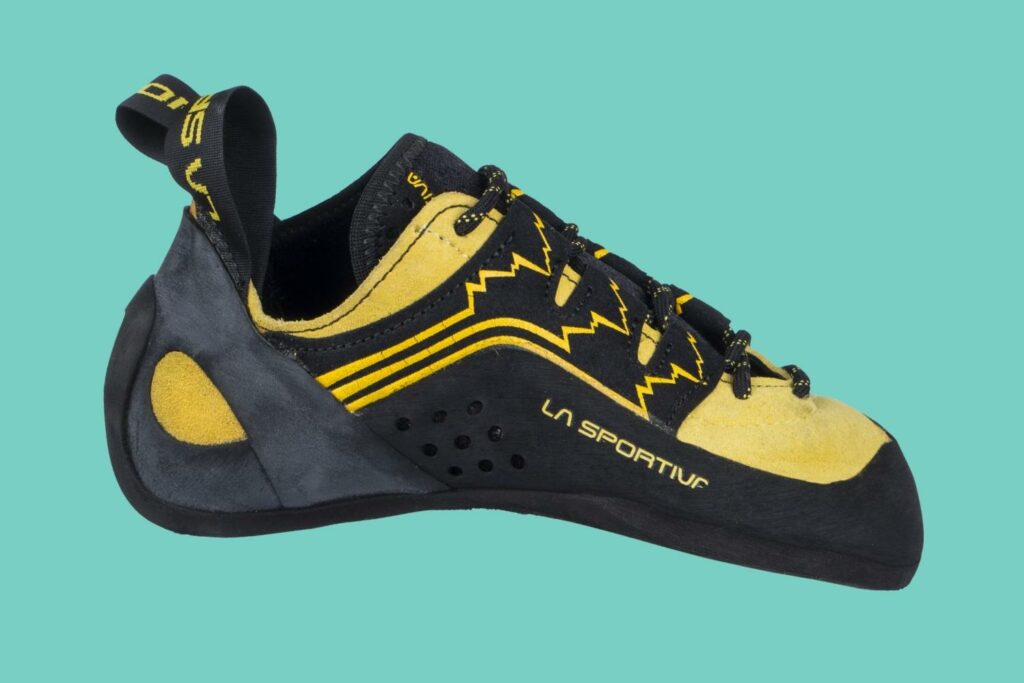
Facts
Outsole Rubber / Thickness: Vibram XS Edge 4mm
Upper Material: Synthetic/Leather
Lining Material: Textile
Vegan? No
Resoleable? Yes
Fantastic performance in various conditions from a less aggressive design, the Katana Lace is the last and only shoe that some high-achieving climbers will ever need!
While we considered anointing this model as the best climbing shoe in our Overall category, its peak performance potential is still slightly less than the Miura VS. This means the Katana Lace can still outperform 99% of us mortal climbers and our abilities!
Sincerely though, if you do a significant proportion of crack and trad climbing and still need an elite performing shoe, the Katana Lace is a better choice than the Miura VS.
Indeed, the Katana is somewhat less aggressive and uses laces instead of buckles, making jamming your feet into cracks much more pleasant. And it’s more adept at smearing than the more downturned Miura.
All that said, the Katana Lace can nearly match the most aggressive shoes when it comes to overhangs and micro-edges. It simply takes a little more effort from the user. The heel cup is pretty secure for heel hooks, and there’s reasonably sparse rubber coverage on the top to assist toe hooking on more advanced bouldering problems.
The Katana Lace uses a narrower last than most La Sportiva models to suit lower-volume feet better. Leather uppers and a partial lining mean the shoe will stretch slightly over time but not excessively. We recommend sizing one-half to one size below normal street shoe size.
If your jam is techy sport climbing, semi-steep bouldering, or high-level gym climbing, you should try the La Sportiva Katana Lace.
Pros
Cons
Read the La Sportiva Katana Lace review
Alternative Pick: Tenaya Tarifa
Very similar to the Katana, but more comfortable, less technical shoe, softer shoes (and 100% vegan). Some reviewers with narrow feet claim this climbing shoe fits them better than any other performance shoes.
4. La Sportiva TC Pro: Best Crack/Trad Climbing Shoes

Facts
Outsole Rubber / Thickness: Vibram XS Edge 4mm
Upper Material: ECO Leather
Lining Material: Textile (partial)
Vegan? No
Resoleable? Yes
This is the only climbing shoe on our list that’s also a movie star, with a leading role in the recent climbing blockbusters, Free Solo and The Dawn Wall. If you haven’t seen those films, they also star climbers Alex Honnold and Tommy Caldwell, who wear La Sportiva TC Pro shoes as they scale Yosemite’s El Cap.
And in case you didn’t know, the “TC” in TC Pro are Tommy Caldwell’s initials since he helped design the original shoe. The latest model was updated in 2021 and also included Honnold’s input.
The hallmarks of a great traditional climbing shoe are comfort, stiffness, and protection, and the TC Pro nails all three. Built on a medium-wide last, the shoes are designed for a climber’s feet to lie flat, making jamming toes and feet into cracks as painless as possible.
The thick, rigid midsole makes the TC Pro stiff enough to make standing on thin edges easy, a must for multi-pitch climbing shoes on difficult terrain. Surprisingly considering this stiffness, TC Pros still smear at a high level on steep slabs and slippery dihedrals.
When it comes to protection, padded, mid-high ankles and a rand covering most of the bottom half of the shoe contribute to a very secure feeling. These shoes take a lot of abuse and keep you from feeling too much pain.
Aside from its steep price, the only negative factors about this shoe relate to its performance on terrain that it wasn’t designed to cope with. La Sportiva TC Pros aren’t for bouldering or technical face climbing; they’re a tightly focused trad and crack climbing shoe. If that’s the majority of what you do, you have to try a pair.
Pros
Cons
Alternative Pick: Five Ten Moccasym
Both the classic Anasazi and the new NIAD (Nose in a Day) versions feature flat, soft construction that molds to the shape of one’s foot and lets experienced climbers smear and jam in comfort all day. An opposite take from the stiff, protective nature of the TC Pro, still outstanding for less demanding technical challenges.
5. Scarpa Instinct VS: Best Bouldering Shoes
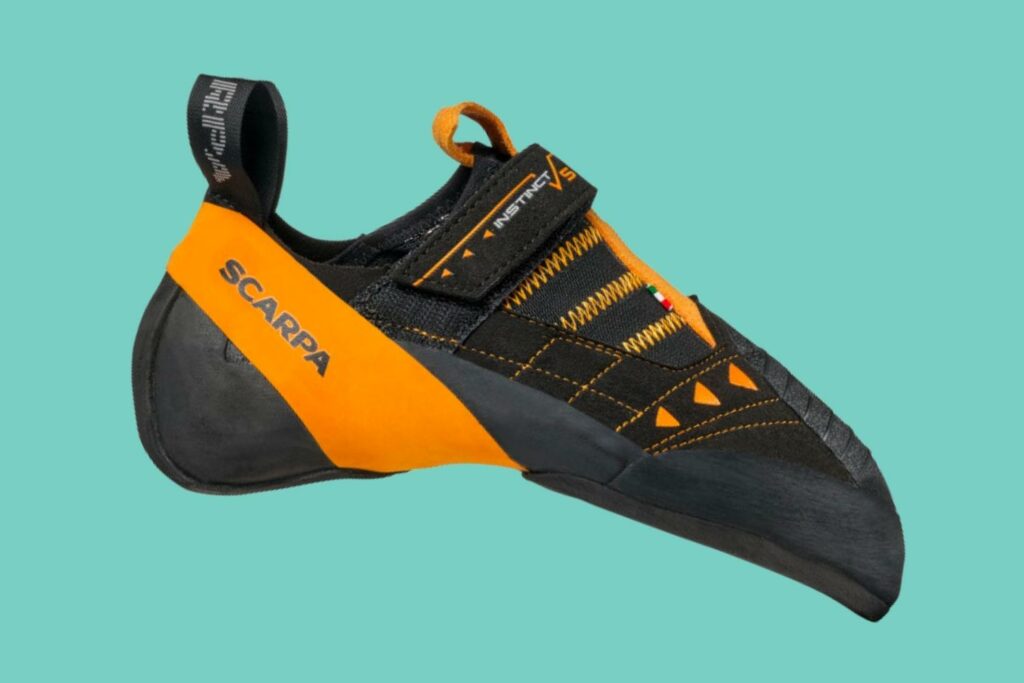
Facts
Outsole Rubber / Thickness: Vibram XS Edge 3.5mm
Upper Material: Leather/Synthetic
Lining Material: Unlined
Vegan? No
Resoleable? Yes
The Scarpa Instinct VS is a member of Scarpa’s Performance line of shoes, and for the majority of reviewers, it delivers on that promise. Marketed as a shoe for bouldering, steep sport routes, and technical face climbing, this model is not simply for overhang specialists.
Built on a moderately downturned and asymmetrical last, this shoe benefits from the increased comfort of a semi-aggressive design. Don’t think this limits its ability when the going gets steep, though.
There is a trend in high-performance bouldering shoes towards exaggerated downturns and super softness, but a shoe like the Instinct VS succeeds by swimming against this current to some extent. It incorporates a 1.0 mm midsole to enhance stiffness and improve edging capability over its softer peers.
Its less aggressive shape also helps when the terrain turns less than vertical. This allows the Scarpa Instinct VS to flex and smear better on slabs and tricky corners than more conventionally designed bouldering shoes.
While Scarpa often has a reputation for lasts that fit lower-volume feet, the Instinct fits climbers with wider forefeet with its generous toe box. This somewhat limits its usefulness in cracks…one of this shoe’s few weak points.
If you like the sound of the Instinct and want an even softer, more sensitive design, Scarpa recently released the Instinct VSR. Differences include reduced stiffness in the midsole and XS Grip2 rubber instead of the harder Vibram XS Edge rubber compound.
Pros
Cons
Alternative Pick: Evolv Phantom
Designed by boulderers for boulderers, this high-tech, high-performance shoe is a collaboration between Evolv, Daniel Woods, and Paul Robinson. The Phantom‘s technical, aggressive design and sensitive yet supportive feel check all the boxes for a dominating modern bouldering shoe. Buy it here
6. La Sportiva Solution Comp: Best Steep Sport Climbing Shoes
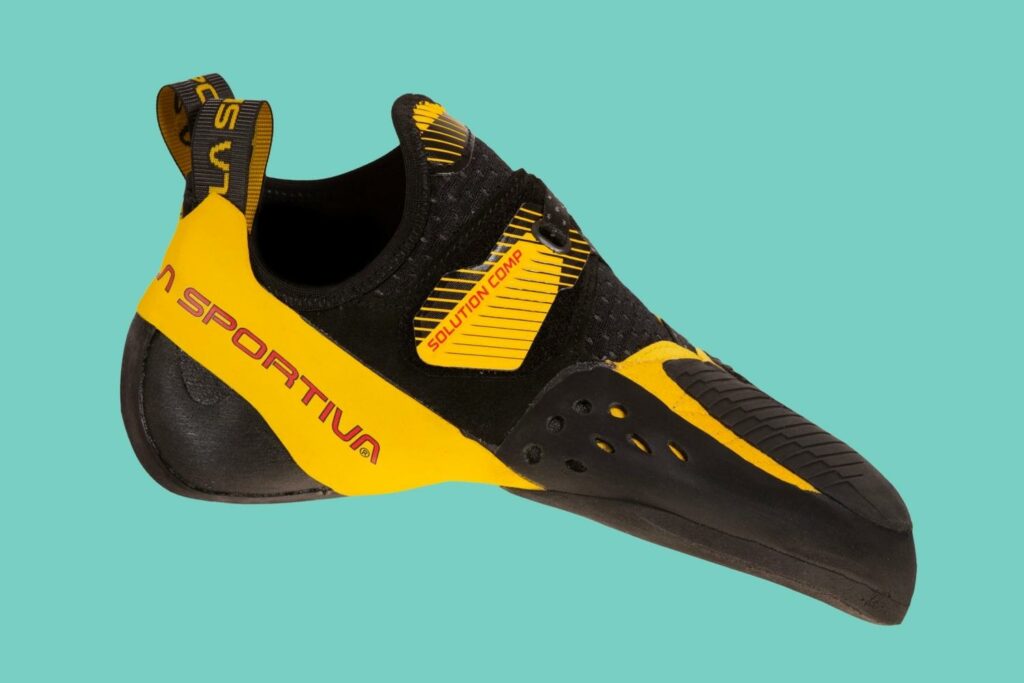
Facts
Outsole Rubber / Thickness: Vibram XS Grip2 3.5mm
Upper Material: Leather/Synthetic
Lining Material: Textile (partial)
Vegan? No
Resoleable? Yes
The La Sportiva Solution Comp is an update on the venerable Solution, which was already known as one of the best options for steep, technical face climbs and hard gym routes.
The new Solution Comp improves on the original with a more sensitive, streamlined heel that eliminates the Solutions’ hard, molded heel cup. Reviewers almost unanimously agreed that this change greatly improves heel hooking ability.
The shoes come with more rubber on top of the forefoot to boost performance on toe hooks and scums at the front. The toe of the Solution Comp is where all your power is focused, and it narrows down to the point that will hook onto the smallest of features and take more strain off your fingers than you thought possible.
Fortunately, La Sportiva didn’t change the things that made the Solution popular shoes to begin with:
- Incredible edging power thanks to a relatively stiff midsole in the forefoot
- A toe profile that fits tiny pockets and thin cracks
- An acceptable level of comfort for such an aggressively shaped shoe
However, The Solution Comp falls short in cracks, where your curled toes will scream if you try jamming and torquing anything between fingers and hand size. The sensitivity in the rear half of the shoe can also be fatiguing on long, less-than-vertical pitches, so this isn’t the best for technical smearing and low-angle test pieces.
But if you’re the type of climber who is constantly pushing the limits of steep climbing performance and need the best, most refined tool, the Solution Comp is like a sports car for your feet.
Pros
Cons
Alternative Pick: La Sportiva Genius
Another soft, sensitive, downturned shoe designed especially for steep terrain, the most unusual features of the Genius are its unique no-edge sole design and offset lacing. Likely due to these differences from traditional climbing shoe construction, opinions of this shoe vary greatly.
7. Black Diamond Aspect: Best Low-Angle Climbing Shoes

Facts
Outsole Rubber / Thickness: NeoFriction Force 4.3mm
Upper Material: Leather
Lining Material: Hemp
Vegan? No
Resoleable? Yes
Designed and marketed as trad climbing shoes equally at home on slabs and cracks, the flat-lasted Aspects are an excellent choice for those who may not need the elite technical performance and matching price tag of La Sportiva TC Pros.
Not that the Aspect isn’t capable of long, steep, multi-pitch climbing. It has a stiff midsole that lets you stand on minimal edges all day without tiring. And a thickly padded tongue that helps all-day comfort as well as its foot jamming ability.
The Aspect has another unique feature that may prolong its durability in cracks: a portion of the leather upper extends over the lower laces of the shoe where they attach, which also gives the wearer’s forefoot and toes extra protection.
One potential negative of this shoe is the lack of ankle protection that some other trad-specific shoes offer. That’s one reason we don’t consider it a top choice for cracks. However, the low-cut design does contribute to the Aspect’s greater flexibility and sensitivity, at least for a stiff shoe.
A fair summary of the Aspect’s performance might be that it is slightly less adept at edging than TC Pros while offering more sensitivity for smearing and technical slabs. That’s why we selected the Black Diamond Aspect as 2024‘s best climbing shoe for low-angle climbing.
Pros
Cons
Read the Black Diamond Aspect review
Alternative Pick: La Sportiva Mythos Eco
The original La Sportiva Mythos is a classic flat, unlined leather climbing shoe known for its ability to stretch multiple sizes and mold itself to the shape of one’s foot. The updated Mythos Eco offers essentially the same low-moderate performance and high comfort with new materials.
8. Five Ten NIAD VCS: Best All-Day Shoes
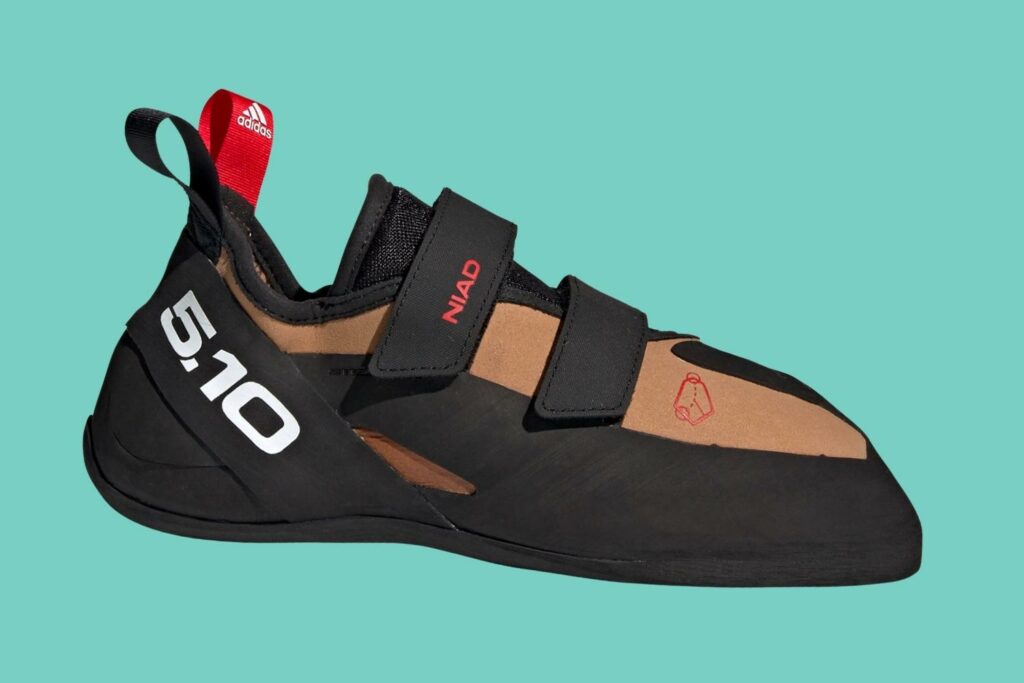
Facts
Outsole Rubber / Thickness: Stealth C4 3.5mm
Upper Material: Leather
Lining Material: Unlined
Vegan? No
Resoleable? Yes
Elite rock climbers don’t only wear ultra-high performance shoes. Sometimes they’re climbing “moderate” 2,000-3,000-foot big walls that are a technical mix of face climbing, smearing, and crack climbing from fingers to off-width.
That’s the ultimate use for Five Ten’s new NIAD VCS, the updated version of the discontinued Anasazi line of shoes, which includes lace and slipper style shoes. The Anasazi models may be the most popular family of climbing shoes ever sold, so we’ll see if the NIAD line holds the same appeal over the next decade.
The NIAD VCS isn’t great at anything, but it’s good at everything. And if you can get the sizing right, you can wear the shoes all day and still climb at a relatively high level on any terrain. You also get high-performing soft rubber with Five Ten Stealth C4.
Users of the old shoe report needing to buy about one size larger in the new Five Ten NIAD shoes, so beware. And the toe box might be narrower, while the heel is wider. Whether this is good or bad depends on your foot.
On the other hand, some positive changes include more rubber over the toe, which helps the shoe’s versatility for hooks and provides a little more protection in cracks. The synthetic upper seems somewhat more breathable than the older version and could reduce sweating in hot conditions.
For climbers who want a separate pair of shoes for long moderates and casual cragging, or for minimalists who don’t aspire to the most difficult sport routes or boulder problems, the Five Ten NIAD VCS might surprise with its blend of comfort and competence.
Pros
Cons
Alternative Pick: Evolv Kronos
This shoe is a slightly more aggressive, less expensive version of the Five Ten. The Kronos sports Evolv’s variable thickness rand and a highly adjustable strap system to dial in a custom fit.
9. La Sportiva Tarantulace: Best Budget Climbing Shoes
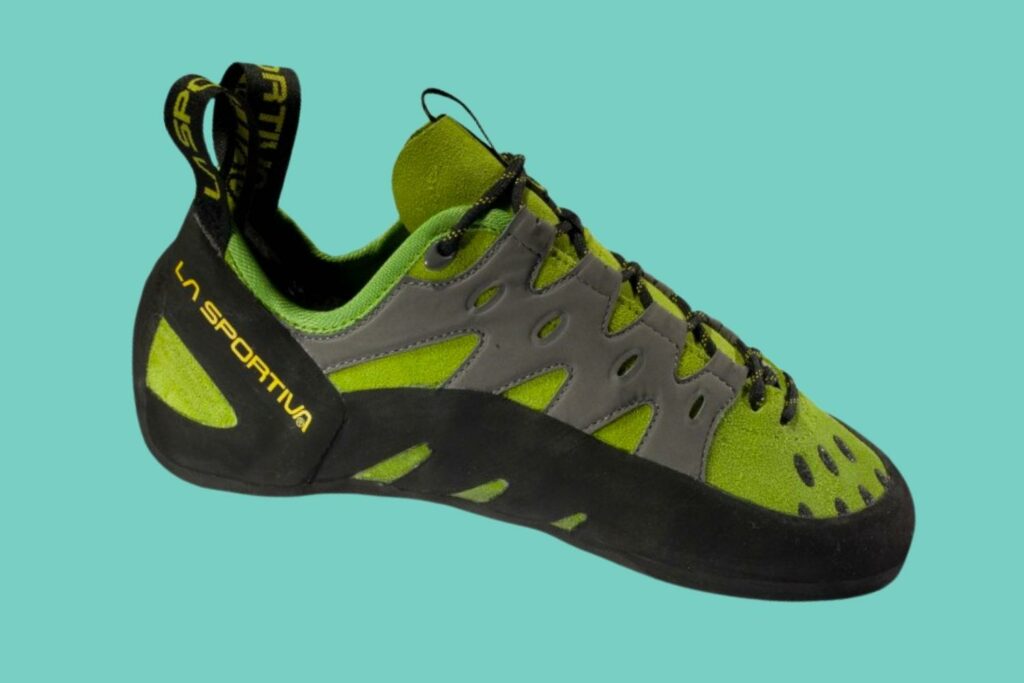
Facts
Outsole Rubber / Thickness: FriXion RS 5mm
Upper Material: Leather
Lining Material: Unlined
Vegan? No
Resoleable? Yes
This La Sportiva climbing shoe is often named one of the best beginner climbing shoes, and it is undoubtedly a winning choice for that purpose. However, relegating this model to the ranks of newbies sells its capabilities short as a low-cost all-around climbing shoe.
This relatively flat, lace-up climbing shoe may never climb 5.13 or V7 gracefully. Fortunately for bargain hunters, most climbers will never achieve those lofty heights either! That’s why, aside from beginners, this shoe also has a cult following among more experienced climbers skeptical of the “tighter is better” philosophy.
If you don’t need to climb horizontal roofs, stand on dime-thin flakes, or attempt technical heel hooks and other advanced techniques, the Tarantulace is up for the task. While it doesn’t excel at any particular discipline, its only major weakness comes on steep terrain with precision footwork.
Otherwise, its comfortable construction and wider forefoot deliver an acceptable performance on moderate crack climbs, slabs, and sport routes. Even if imprecise on edges and too blunt for tiny pockets, the laces do make up for some of that sloppiness by allowing a more custom fit than Velcro closures or slipper-type shoes do.
And the 5 mm rubber on the sole means longer intervals between resoles. At less than half the price of the “elite” shoes, the La Sportiva Tarantulace is hard to beat as an affordable climbing shoe option.
Pros
Cons
Read the La Sportiva Tarantulace review
Alternative Pick: Tenaya Tanta
A more capable option for just a few dollars more, the Tanta will also let users attain higher grades before feeling the need for a more expensive, aggressively shaped shoe.
10. Tenaya Oasi: Best Vegan Shoes
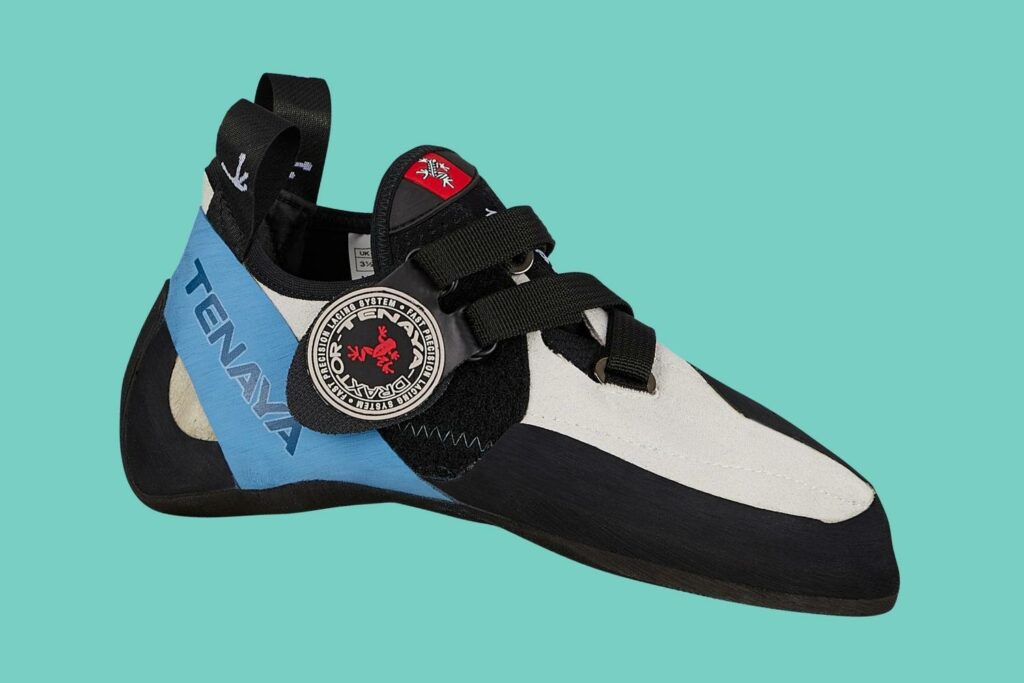
Facts
Outsole Rubber / Thickness: Vibram XS Grip 3.5mm
Upper Material: Synthetic
Lining Material: Textile – Cotton
Vegan? Yes
Resoleable? Yes
Tenaya’s most aggressive shoes feature sharply downturned toes for power on steep sport routes and other situations that require highly technical footwork and precision. Alex Megos has worn this shoe to climb 5.15, so you know it has the prowess for any challenge.
We chose these as category winners not necessarily because they’re the “most vegan” but due to their supreme crushing abilities combined with futuristic comfort when paired with the right foot. In fact, it’s almost hard to believe the resounding compliments the Tenaya Oasi receives from users for its outstanding wearability.
The Oasi doesn’t require a long break-in for most climbers, and the synthetic upper stretches very little, so don’t downsize too much. Most people can dial in a great fit with Tenaya’s unique double strap system, which allows you to cinch down the forefoot, midfoot, and heel areas separately.
The only major reported negative from testers and reviewers of the Tenaya Oasi is that the sole may tend to delaminate where the front of the outsole and the rand come together. It’s unclear whether this is a quality control issue or has some other cause, as most reviewers don’t report it.
In light of all this, if you’re in the market for an ultra high-performing, vegan-friendly shoe, you can put the Oasi on your shortlist.
Pros
Cons
Alternative Pick: Evolv Defy
When you don’t need or want to climb 5.15 and may not want to spend $200 not to do it. Evolv’s Defy is sold as an entry-level shoe but has the capability to push into intermediate grades, whether indoor climbing or outside on real rock.
11. La Sportiva Otaki Women’s: Best Women’s Climbing Shoes
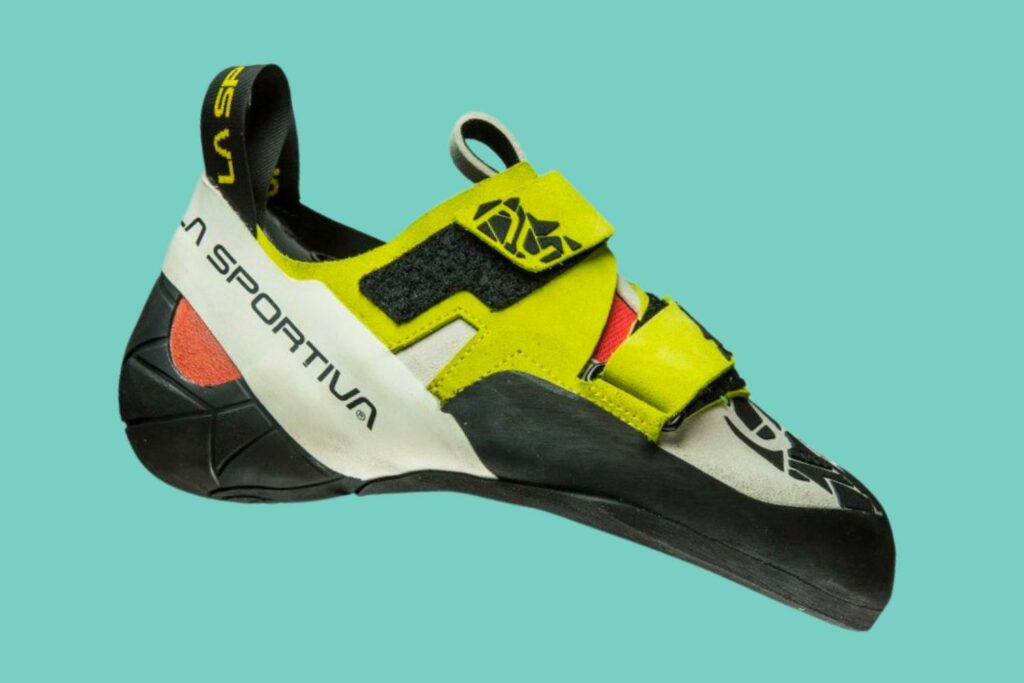
Facts
Outsole Rubber / Thickness: Vibram XS Grip2 4mm
Upper Material: Leather/Synthetic
Lining Material: Textile (partial)
Vegan? No
Resoleable? Yes
A member of La Sportiva’s performance line, the Otaki women’s version is a medium-volume, moderately aggressive model that users find incredibly comfortable for a fairly wide variety of foot types while giving an almost-elite performance.
Most of us don’t climb V9 or 5.13, but we still want climbing shoes that make moderate grades easier and help us climb with more grace and less effort. The La Sportiva Otaki does just that, on terrain from overhung to vertical that comprises the vast majority of most climbers’ diet.
Most reviewers of the Otaki women’s report purchasing as an upgrade from lower-performing shoes, and they unanimously raved about the increase in performance the shoe gives them in edging, pulling in on steep roofs, and toeing the smallest chips and jibs.
While precision footwork is the Otaki’s forte, this shoe isn’t the best for highly technical bouldering techniques. Although the heel is very grippy and secure, the thin rubber patches across the toe don’t inspire confidence.
There are other shoes designed for women that offer higher performance and less comfort if that’s what you require. But if you’re not a climbing pro and still want a high-performance shoe that can hang on just about any route your throw at it, try on a pair of La Sportiva Otaki women’s.
Pros
Cons
Read the La Sportiva Otaki review
Alternative Pick: Scarpa Vapor V Women’s
Built on a narrower last than the Otaki, the Scarpa Vapor V is another semi-aggressive, highly capable shoe for intermediate climbers and up.
For more options, check out our selection of the best climbing models for women.
12. Butora Acro Comp: Best Shoes for Indoor Competition Climbing
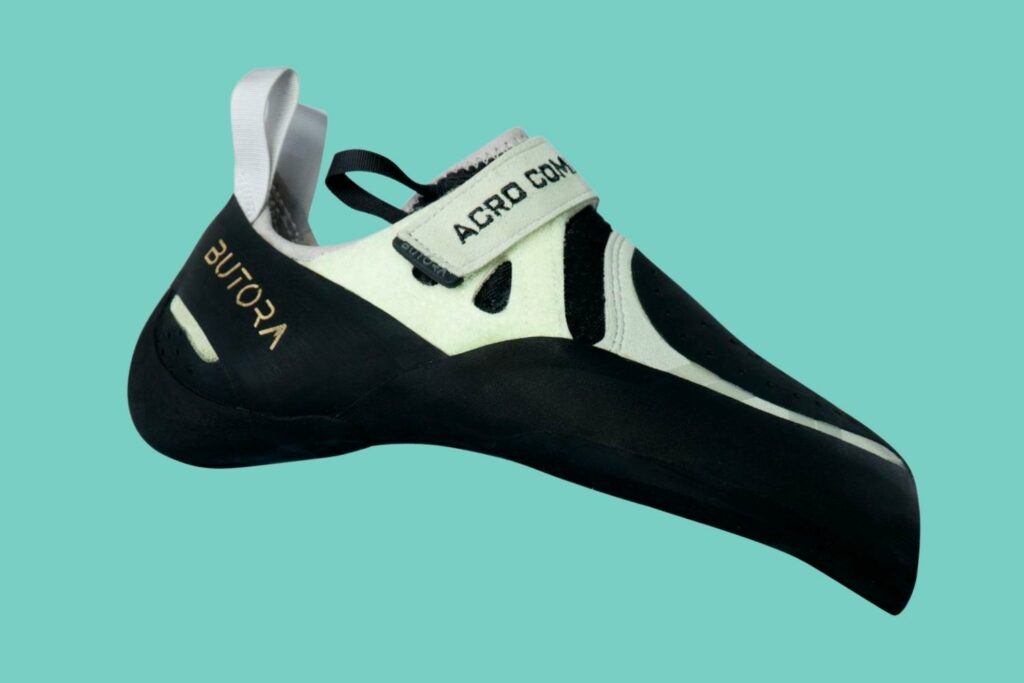
Facts
Outsole Rubber / Thickness: NEO Fuse 4mm
Upper Material: Leather
Lining Material: Unlined
Vegan? No
Resoleable? Yes
This aggressively shaped but very flexible shoe is a softer version of the Korean manufacturer’s Acro model. Specially created for steep terrain and gym climbing, like other Butora models, the Acro Comp is sold in both narrow and wide versions for a more customized individual fit.
Korea produces some of the world’s best competition climbers, so it’s not surprising that Butora makes a shoe model that excels in the gym. In the climbing shoe world, the rock gym is the place of slippery plastic holds and terrain that goes from vertical to horizontal.
This is the terrain where the Acro Comp shines. From the soft, grippy heel to the rubber-covered toe that grabs hold of anything, the feel is about as close to barefoot as you’ll find in a climbing shoe.
Due to its softness, the Acro Comp’s edging ability is more smedging when it comes to the smallest of holds, but it’s still very secure. For the same reason, smearing walls and volumes with the NeoFuse rubber sole is a dream, despite the extreme downward curvature.
On the downside, the one-strap system doesn’t allow for much adjustability. That is offset by the pliant, form-fitting nature of the Acro Comp. It’s close to a slipper in feel and flexibility.
This softness means durability might be a factor if you want to use this shoe outside.
However, the highest and best use for this shoe is in the gym. That’s why we named it our best climbing shoe for indoor gym climbing of 2024.
Pros
Cons
Read the Butora Acro Comp review
Alternative Pick: Scarpa Veloce
Scarpa’s formula for an ideal gym climbing shoe includes a roomier toe box so indoor climbers can leave their shoes on longer without pain. The Veloce isn’t the shoe to send your hardest boulder problems or sport routes, but for beginner climbers to intermediate, it’s a more affordable alternative to elite-level shoes.
13. Black Diamond Momentum Kid’s: Best Kid’s Climbing Shoes
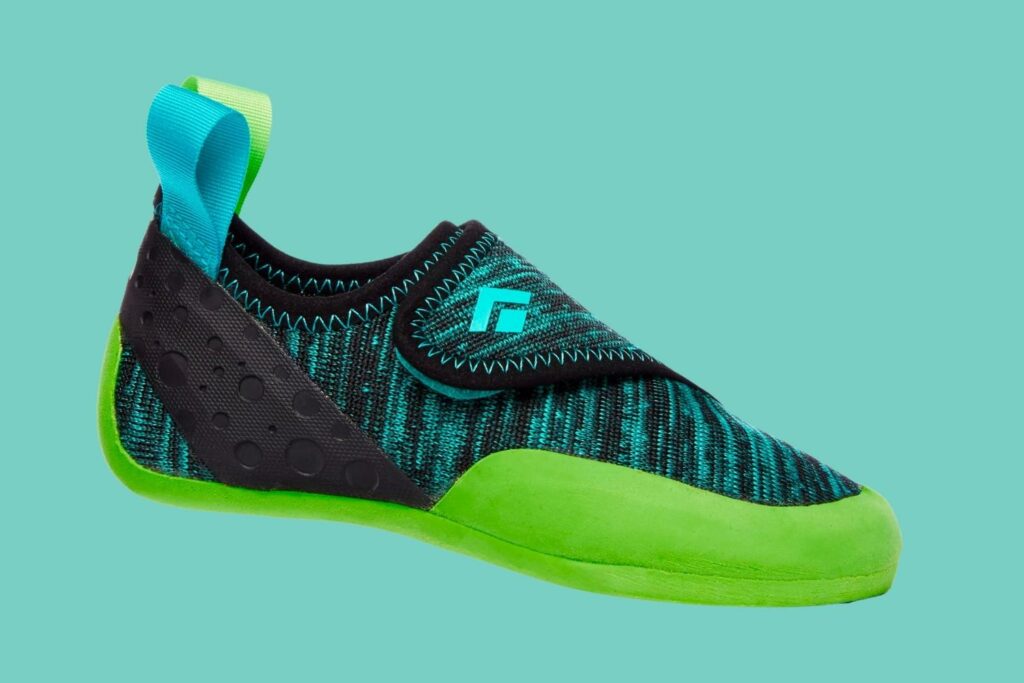
Facts
Outsole Rubber / Thickness: NeoFriction 4.3mm
Upper Material: Synthetic Knit
Lining Material: Microfiber
Vegan? Yes
Resoleable? Yes
The most important features in a kid’s first pair of climbing shoes are fit and comfort. You shouldn’t size them as tight as you might an adult’s shoes, because pain is no fun. On the other hand, you want them to be snug enough to give young climbers confidence on small footholds
Fortunately, Black Diamond’s Momentum kid’s climbing shoes have a fabric upper that breathes better than some traditional materials like leather. While it’s not very stretchy, it will mold to the top of one’s foot and feels secure with the single velcro closure.
Flat and moderately asymmetrical, these shoes won’t pinch or prevent kids from walking around the gym or the crag base while wearing them. And they’ll probably outgrow them before wearing them out, as they have a 4.3 mm sole and durable rand.
Some users do report chafing from a seam inside the upper. If this is an issue, a thin pair of socks might be enough to address the issue.
Pros
Cons
Alternative Pick: Evolv Ashima
If your child is crushing V10 at age 10 like this shoe’s namesake, you probably need to find a higher-performing shoe than most of the models designed for kids. The Evolv Ashima is one of the few kid’s models with an aggressive, downturned shape intended for precise footwork on difficult terrain.
14. La Sportiva Skwama: Best for High-Volume Feet

Facts
Outsole Rubber / Thickness: Vibram XS Grip 2.4mm
Upper Material: Leather/Synthetic
Lining Material: Unlined
Vegan? No
Resoleable? Yes
This semi-aggressive, intermediate to advanced performer gets top marks from users with wide feet who don’t fit other high-performance shoes. An unlined, leather/synthetic shoe, the Skwama is an all-rounder that can climb into higher grades when called upon.
Mainly designed and used for steep climbing and bouldering, the Skwama has great smearing sensitivity not always found in performance-biased, aggressive shoes. At the same time, the midsole beneath the toe is stiff enough to help stick securely on micro edges and crystals.
The single velcro strap, along with extensive rubber over the top of the shoe, makes the Skwama superb for hooking, scumming, and other footwork shenanigans. The heel isn’t universally liked, but that seems to stem from differences in wearers’ heel volumes.
While most people use them for hard, technical climbing, some users find the Skwamas suitable for trad climbing. Just be warned; they may wear out quickly in this application.
The soft middle portion of the shoe also doesn’t provide much support for long climbs where you’re standing on small edges consistently for long periods so that the Skwama may be better suited for single-pitch routes and boulder problems.
If you have wider feet and have been seeking an intermediate to high-performing rock climbing shoe that can push your limits in a wide variety of conditions, the La Sportiva Skwama may be the right choice.
Pros
Cons
Alternative Pick: Evolv Shaman
The Shamans are a classic high-performance all arounder designed with America’s climbing rock star Chris Sharma and lauded for their great comfort for wider feet, along with their respectable performance for steep sport climbing and overhanging, technical terrain.
15. Tenaya Iati: Best Low-Volume Shoes
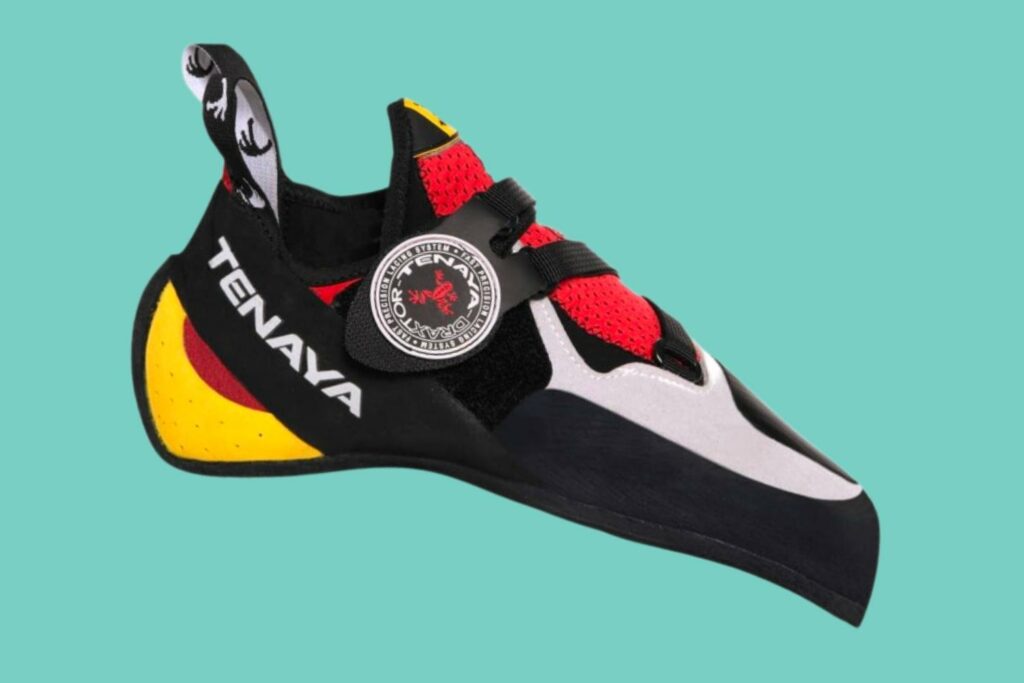
Facts
Outsole Rubber / Thickness: Vibram XS Grip 3.5mm
Upper Material: Leather/Synthetic
Lining Material: Textile – Cotton
Vegan? No
Resoleable? Yes
The Tenaya brand is known for building shoes using lower-volume lasts than many manufacturers, and climbers with narrow feet generally have positive things to say about the fit of Tenaya models.
Not to say climbers with wider feet shouldn’t try the Iati. The improved double velcro strap system gives a lot more flexibility in sizing than some closure systems.
The Iati stands out for its excellent abilities in nearly every environment. A more asymmetrical shoe than Tenaya’s Oasi, with a stiffer midsole that gives excellent edging support for such an otherwise soft and comfortable climbing shoe.
The Iati’s edging power comes partially from its slightly downturned and asymmetrical shape. The rest comes from the midsole, thicker than most shoes designed for steep, technical climbing. The toe comes to a fairly severe point, great for hooking onto small pebbles and pockets.
This shoe can handle any boulder, steep lead climb, or gym route that you can throw at it with style. The combination of stiffness and downturn means it’s not a great performer on foot jams or super techy smearing, though.
According to testers, the biggest benefit of this shoe, aside from its performance potential, is the pain-free fit relative to its capabilities. A two-layer tongue and liner material create a sock-like fit around one’s foot and reduce or eliminate pressure points.
If you have a lower-volume, narrow foot and want a comfortable shoe that can climb as hard as Alex Megos, look no farther than the Tenaya Iati.
Pros
Cons
Read our review of the Tenaya Iati
Alternative Pick: Scarpa Drago LV
Incredibly soft and sensitive, best for acrobatic overhang moves and other steep climbing stunts. Their weak midsole will make you tired of slab climbing, so stay on overhanging to vertical terrain (read our Scarpa Drago review).
Anatomy of a Rock Climbing Shoe

We’ll discuss several different shoe characteristics that affect how climbing shoes feel and perform on your feet.
Stiff vs. Soft Shoes
One important shoe characteristic is its degree of stiffness. A soft, sensitive shoe can be desirable because it allows one to feel small holds better and perhaps optimize the angle and grip of the shoe.
However, too-soft shoes can deform and roll off tiny holds more easily. Also, soft, sensitive shoes require more foot and toe strength to maintain tension against the rock.
Stiff shoes are less sensitive but contribute more power to a climber’s foot to help stay on ultra-thin edges and tiny nubbins. Climbing a long route on small edges with stiffer shoes is much less fatiguing for your calf and foot muscles as they provide a structured, solid platform under your toes.
Sole Shape and Shoe Performance
Another variable among shoe models is the degree of toe downturn, from flat to extremely curved.
Flat shoes (comfort)
A flat-lasted shoe is generally more comfortable for longer routes and better at smearing and other low-angle footwork techniques.
Downturned shoes (performance)
A more downturned shoe provides more support and leverage on small footholds and overhanging, steep routes.
Extremely downturned shoes also tend to be more asymmetrical, another common characteristic of high-performance, aggressive shoes. Asymmetry means a shoe curves inward from heel to toe.
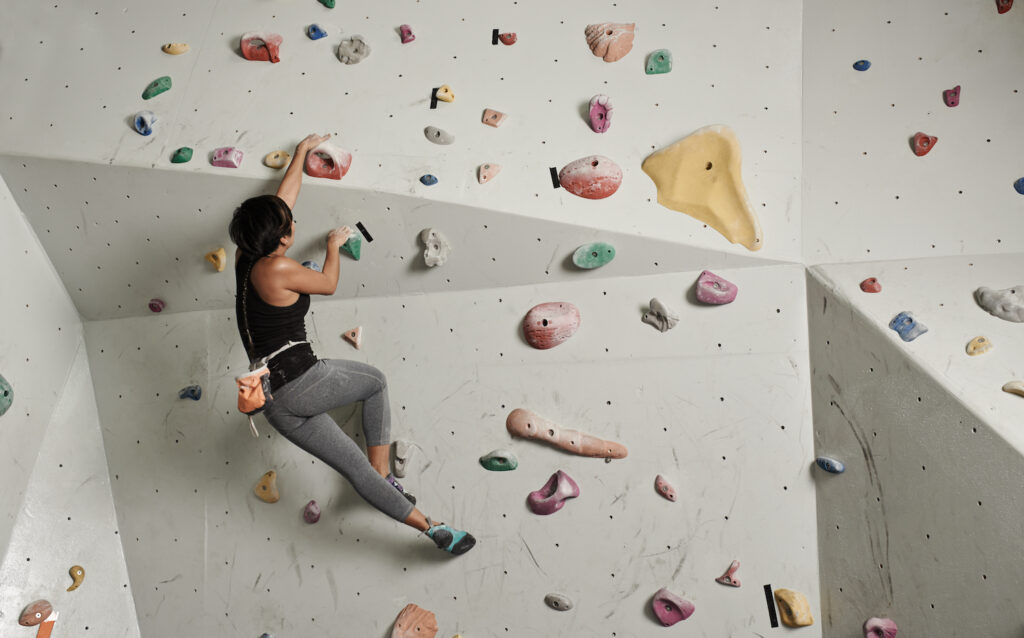
When combined with a downward curve, asymmetry allows a climber to concentrate all their power on a very small point of contact and to use their toes to almost hook onto minuscule ripples and pockets.
Of course, all this performance sometimes comes at the price of comfort.
Radically downturned and curved shoes aren’t comfortable for lounging or walking, so you’ll be taking them off as soon as you get back down to the ground. They also may not be as effective as flatter shoes for smearing on low-angle climbs or for wedging one’s foot into cracks while trad climbing.
Climbing Shoe Rubber
Modern climbing shoes essentially provide two advantages: one, their ultra-tight fit means no sloppiness or movement of your foot inside the shoe. Secondly, the sole material is much, much softer and stickier than the outsole of a typical athletic shoe.
Shoe manufacturers either use their proprietary formulations of rubber, like Five Ten’s various flavors of Stealth, or they use a third party’s product. For example, La Sportiva and several other companies use different varieties of rubber made by Vibram, called XS Edge and XS Grip. Climbers report that XS Edge is harder and more durable, while XS Grip is softer and stickier.
Different Shoes for Different Purposes
The choice of your climbing shoes will largely depend on your type of climbing. Unfortunately, no company has made a shoe that is excellent at everything, from overhung boulder problems, long slabs, and cracks to high-performance sport routes.
Also, most climbers don’t want to carry around more than one or two pairs of shoes to the gym or the crag, so we all compromise to some extent. As a result, the most suitable pick for any individual will always be very subjective and reflect personal preferences and priorities.
As highlighted in our selection, the main styles of climbing are the following. You should pick one model that fits the most closely to your kind of climbing and experience level:
- Bouldering
- Sport climbing
- Traditional climbing
For more information, check out our guide How to Choose Climbing Shoes.
Where to Buy Climbing Shoes?
Anywhere, if you find the perfect fit and the price is right! Of course, it can be tricky to find the proper size if you’re purchasing a new model that you’re not familiar with (especially if it’s a new brand!). However, it’s doable if you do some research. The easiest is to go for shoes that climbers unanimously recognize as having a street size fit.
In general, we buy most of our stuff from REI. Not only their service is on point, but it’s also a cooperative, so they treat their employees well and prioritize members over shareholders.
Another underrated option is to buy a used pair of the model you are interested in to try it out. This will allow you to determine if it suits your practice and morphology and figure out the sizing.
For more information, check out our guide on where to buy climbing shoes.
FAQs
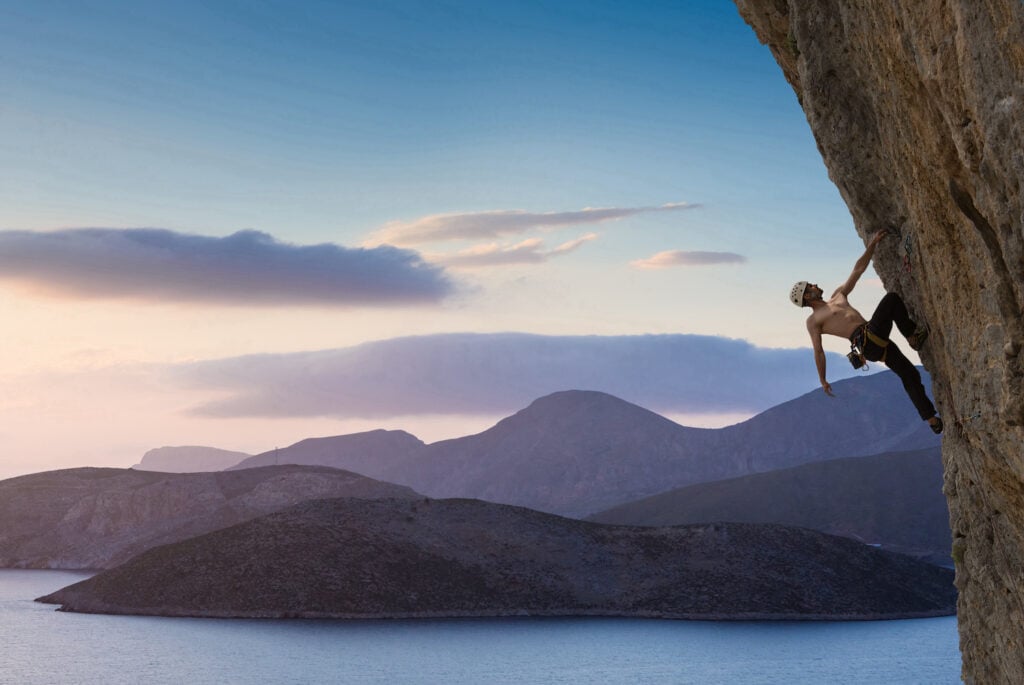
This is a very personal decision. Some old-school climbers will insist everyone downsize 1 or 2 sizes from their regular shoe size. This is ridiculous, mainly because there is no consistency among climbing shoe manufacturers regarding sizing. Check online reviews for sizing advice on a particular model before you order. Generally, shoes constructed with a leather upper will stretch one-half to one size after a break-in period, and shoes with synthetic uppers or full linings will stretch much less or not at all.
Lace-up climbing shoes will always give you the most flexibility in terms of fit. With eyelets that reach closer to the toe than most shoes, rock shoes aim to let you really cinch down the area around the toe box and wherever else you need it. Laces also provide more security and prevent your shoe from coming off when you wedge it into a crack or attempt aggressive heel hooks. However, shoes with velcro straps and slipper-style models are much more convenient to put on and remove if you can achieve a tight enough fit.
A last is essentially a three-dimensional model or mold that a shoe is built on that mimics the shape of a typical human foot. Every shoe manufacturer uses several different lasts to make shoes with different characteristics: width in the heel, midfoot, and toe box; overall volume; toe profile; etc. Some climbers find that one particular manufacturer uses last designs that fit their feet better than others. However, since every last is different, most people still need to try on any new model to ensure it has a similar fit to a known model in a manufacturer’s lineup.
For regular climbers who get outside or to the climbing gym at least a couple of times a month, you’ll wear the soles of your climbing shoes down fairly quickly. Or it may be more accurate to say you’ll wear them out in one tiny spot that must be repaired before they become too damaged to be fixed. Considering the cost of a resole is $30-50, compared to $140-200 for the average climbing shoe purchase, my friends all resole their shoes at least once or twice before trashing them.
While we have never seen a scientific attempt to measure friction variability in different climbing rubbers, most climbers have an opinion and preferences. Five Ten’s Stealth C4 rubber is often touted as the “stickiest” outsole rubber, both by Five Ten and many long-time climbers. Vibram offers two hardness levels, with Vibram XS Edge rubber being harder, stiffer, and more durable, and XS Grip (and the updated Grip2) providing a softer, grippier feel. How much of our confidence in our footwork is based on mental belief and marketing? And how much comes from better grip via rubber technology? We may never know.
References:
